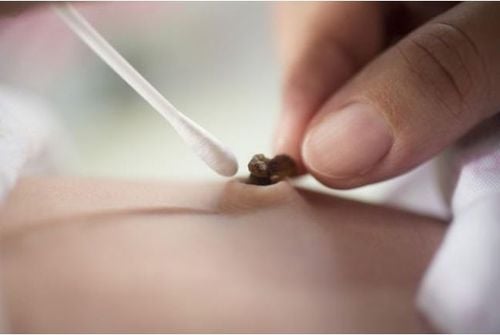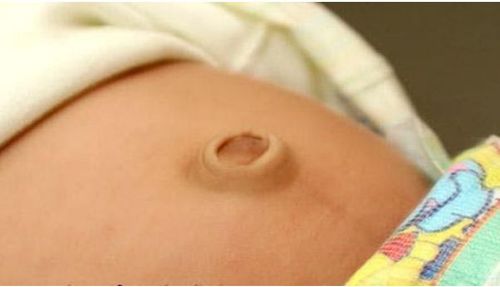This is an automatically translated article.
Article written by Master, Resident Doctor Dang Thi Ngoan - Department of Pediatrics - Neonatology - Vinmec Ha Long International Hospital
In the first weeks after birth, the baby's belly button is often a family concern. Many unusual signs in children are often attributed to problems at the navel such as babies crying a lot because of umbilical cord pain,... So what are the most common umbilical diseases affecting children's activities?
1. Common diseases of the navel in babies
1.1. Umbilical infection
Infection of the umbilicus due to invading and pus-producing bacteria, there are 2 types:
Localized umbilical cord infection: red swelling at the base of the umbilicus, the surrounding skin is normal. Diffuse umbilical cord infection: red swelling around the base of the umbilicus and spreading to the surrounding skin, diameter >= 2cm. Signs of an umbilical infection such as the belly button is red, swollen, oozing, pus or the belly button is still wet after falling, has a bad smell, and bleeds. The baby may or may not have a fever, be fussy, or refuse to feed.

Trong những tuần đầu sau sinh, vấn đề về rốn của trẻ thường được gia đình rất quan tâm
1.2. Neonatal umbilical granulomatosis
The disease often occurs in babies with delayed umbilical cord shedding, as this facilitates the development of granulomas. When the umbilical cord has fallen off, but the umbilical cord foot area still has a prolonged yellow discharge, the baby does not have fever or swelling, redness in the navel area. If left undetected, umbilical granulomas in infants can persist leading to umbilical cord infection.
1.3. Neonatal umbilical hernia
Umbilical hernia occurs when the umbilical ring does not close properly after the umbilical cord falls off. The sign is a raised round mass right at the navel. Umbilical hernia, commonly known as umbilical hernia, does not cause pain, rarely causes complications, but only cosmetically affects and heals on its own in the first few years or can be plastic surgery when the baby is older.

Thoát vị rốn xảy ra khi vòng rốn không đóng kín sau khi rụng rốn
1.4. Presence of neonatal urachal tube
Normally, the urachal tube connecting the urogenital sinus and the umbilicus will be closed and fibrosis into the umbilical - bladder ligament during the fetal period. Existence of the umbilical cord is the existence of a tube connecting the navel to the bladder. As such, urine can back up from the bladder into the navel. Damage to the junction between the bladder and the navel to allow urine to pour into the umbilical cord, the umbilical cord always leaks continuously, sometimes the child has a UTI.
1.5. Umbilical bleeding
A few drops of blood on the spot between the dried umbilical cord and the base of the umbilicus, bleeding from rubbing the diaper against the umbilical cord. Bleeding will usually stop or stop with gentle pressure on the navel area with a clean gauze pad.
If the bleeding persists or bleeds heavily (still bleeding after 10 minutes of pressure or continues to bleed more than 3 times), the mother should take the baby to the doctor, because there may be a medical condition causing the umbilical cord bleeding. .
1.6. Navel falls off late
Usually the umbilicus falls off after 10-14 days of age, but in rare cases it can last > 3 weeks. Keep the navel dry and check the skin around the navel every day. Wash off the secretions on the navel gently and pat dry. Be careful not to use alcohol or other antiseptics on the navel. When wearing a diaper, do not let the diaper rest on the umbilical cord. After 3 weeks but the umbilical cord has not fallen off, the mother should take the baby to see a doctor.
1.7. Navel leaking fluid
The umbilical cord is leaking or moist, or there is little pus on the surface, usually occurs after the umbilical cord has fallen, the baby may have a mild infection of the umbilicus or have other umbilical disorders such as the existence of the umbilical cord, umbilical granuloma... Mother should take the baby to the doctor to be screened for umbilical disease and guide how to take care of the umbilical cord.
2. Caring for the umbilical cord for babies
In newborns, the umbilical cord is an open wound, which is easy to get infected if the mother does not take good care of it. This is a very dangerous condition, if not detected and treated in time, can cause complications of blood infection for the child.
The care of the umbilical cord for the newborn needs to be done daily and cleaned according to the following steps:
● Before taking care of the baby's umbilical cord, the mother needs to wash her hands thoroughly and disinfect her hands with 90° alcohol.
● Gently remove the baby's umbilical cord and gauze.
● Observe the umbilical section and the area around the navel to see if the navel is red, inflamed, pus, yellow discharge, bleeding, bad smell or any other abnormalities.
● Wipe the navel with a cotton ball with sterile boiled water, then pat the umbilical cord and umbilical cord areas dry.
● Disinfect the skin around the navel with physiological saline.
● The navel can be left open or just covered with a thin layer of sterile gauze.
● Wrap the diaper area below the navel, avoid letting feces, urine or anything dirty the navel area.
Need to monitor and take care of the umbilical cord for the newborn every day. If you detect one of the following signs, take your baby to the pediatrician immediately:
● The umbilicus is yellow, has a bad smell or has pus.
The navel bleeds a lot and is difficult to control.
● The skin around the navel is swollen and red.
The navel has a bud, a long ooze.
● The navel hasn't fallen off even though the baby has been born for 3 weeks.
● If you see abnormal signs in your baby's belly button, you absolutely must not give antibiotics or any other medicine to your baby without a doctor's prescription.
When a child shows signs of umbilical cord diseases, parents can take the child to Vinmec International General Hospital for examination, diagnosis and treatment. Here, there is a team of well-trained pediatricians with high technical qualifications, rich experience in the treatment of diseases of infants, children and children under 16 years old.
For detailed advice, please come directly to Vinmec Health system or book online HERE.














